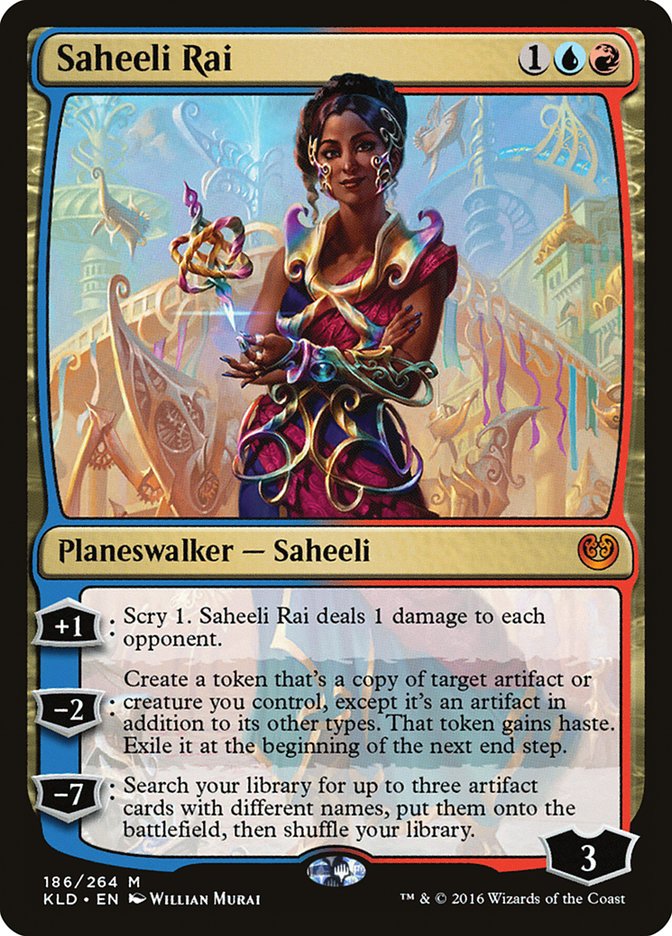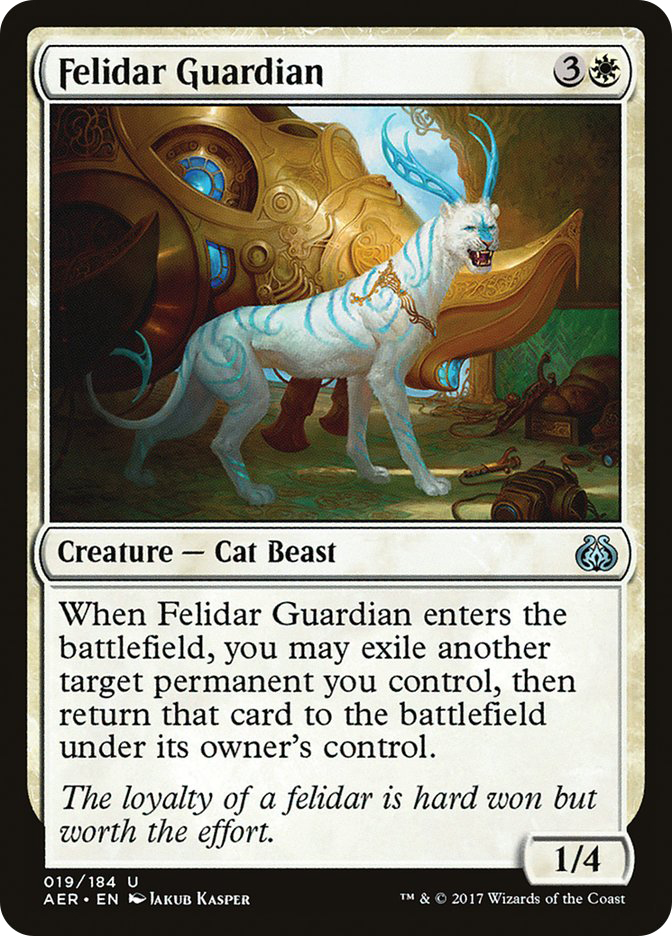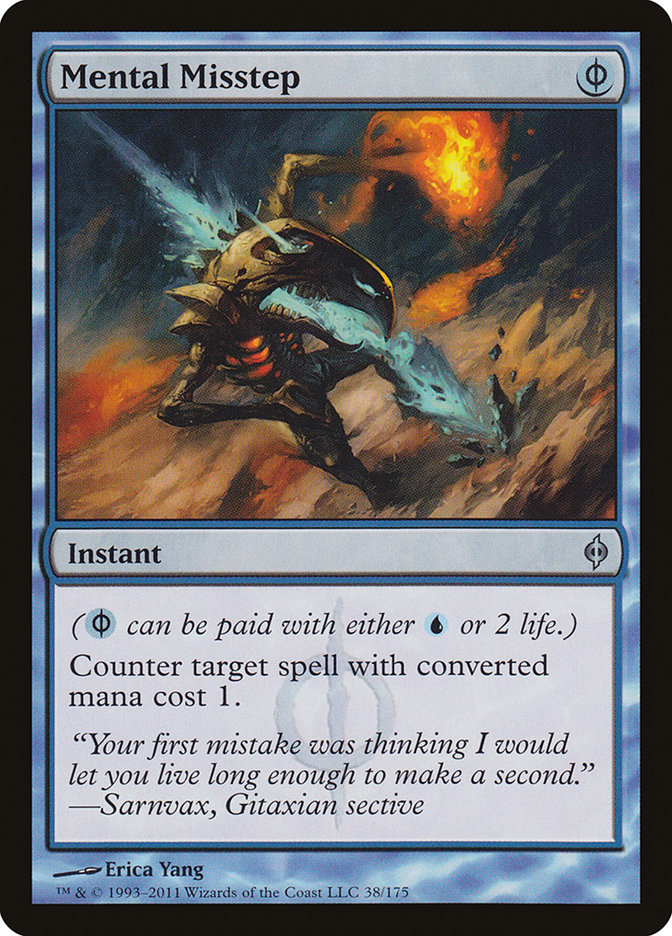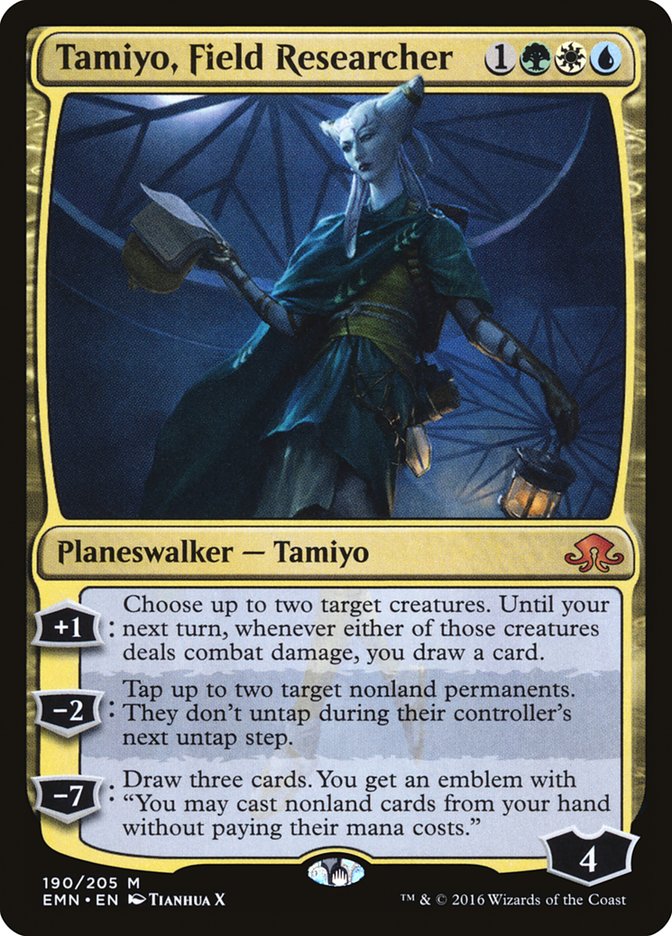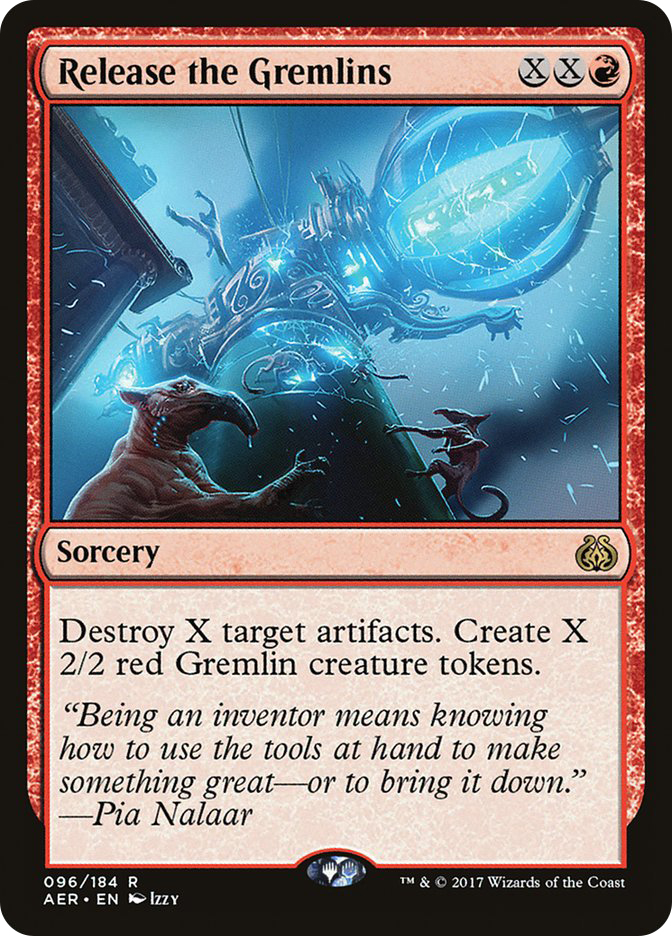I found myself at home this past weekend for the first time since the Aether Revolt Prerelease. It almost felt alien to watch coverage
from the comfort of my own couch as opposed to being apart of it. Not to
say it was bad, just…unique. In all honesty, it was a much needed break
from the road as I was finding myself feeling run down and unimaginative.
The stress-free environment allowed for me to really sink my teeth into
this Standard format and get the much-needed practice in with all of the
decks it had to offer. It didn’t really take that long given how many decks
this format makes up, but I did eventually come to some interesting
conclusions.
The most important being this format is unhealthy, and that’s due to a
certain deck being fundamentally broken.
Q: What do you call it when a Cat wins all the trophies?
A: A cat-has-trophy!
It didn’t take long for me to find a list of Four-Color Saheeli that I
liked. I started entering MTGO leagues. It took even less time for me to
realize that I’ve been on the wrong side of history by not playing this
deck sooner. Much like with last format’s Aetherworks Marvel decks, it took
the collective some time to find the best iteration, but once discovered it
instantly became too good to exist. A deep discussion about the combo’s
merits for ban will have to wait, however, because today we are going to
focus on the here and now. This weekend is the last chance for many to win
their RPTQ and next weekend the Standard Grand Prix is in New Jersey.
Creatures (16)
Planeswalkers (8)
Lands (21)
Spells (15)

Before picking this deck up, my win percentage in Standard post- Aether Revolt was a staggering 80%. It’s only gone up since. Not
by much of course, but that’s still very impressive to me. This deck is
fundamentally broken. The ability to win the game as early as turn 4 or out
of the blue by turn 6 forces an opponent down many unfavorable paths. When
on the backfoot, an opponent may need to hold up mana for removal before
fully developing a battlefield capable of winning the game. This strategy
almost never works since Four-Color Saheeli can then simply play a midrange
game by deploying other permanents. When on the offensive, an opponent must
decide on pressing the advantage by using a removal spell on a blocker or
sacrificing damage output by allowing trades and waiting for the opponent
to “go for it.” This can sometimes lead to Four-Color Saheeli crawling back
into the game it shouldn’t have been in without the fear of a combo. Other
times it doesn’t even matter what the opponent does. The deck is flexible
enough to play a tempo/beatdown, midrange, control, or combo game. The
tools might not be as sharp as those in a more focused strategy, but they
don’t have to be when the fear always exists.
It’s shocking how often this deck actually utilizes the combo to win games.
One would think the “fear” would be used to leverage alternative wins more
often, but those advantages created from paranoia eventually allow the deck
to leverage a win with the combo like some self-fulfilling prophecy. That’s
because it breaks the rules of Magic! The deck only has to play Magic with
its opponent for some amount of time. It’s always different based on the
situation, but the deck is capable of playing a lot of Magic given all the
card advantage. A dance of resources begins, but once backed into the
corner, even for a turn, the opponent can just end up dead. There is no
wiggling out of it or grinding back into a favorable position like we see
in normalized games of Magic.
They just die.
That just shouldn’t exist in Standard!
To make matters worse, both pieces of the combo aren’t embarrassing when
alone. I’d imagine if one piece gets banned, the other will no longer see
play, but that doesn’t change the fact that both cards pull their weight in
this deck. Felidar Guardian doesn’t only have to target Saheeli Rai, and
vice-versa. Flickering Oaths, Planeswalkers, or even creatures often is
enough to consider the turn to be a good one, but it’s often better than
that given time was found to get one of the combo pieces out.
Now the format has warped itself to put up a good fight, and it does to
some extent. Sadly though, it’s a very short list of viable competitors.
Today we will be going over how to play against these decks. Given how
degenerate Four-Color Saheeli is, I will simply be ignoring the games where
you just win. So when I discuss certain strategies against specific decks,
that means I’ve just ignored the times we just beat them with our stupid
deck, and we’ll focus instead on how to play the games until you assemble
the crazy cat lady.
Before we go too far I want to make a few things clear about the
sideboarding suggestions I’ll make in this article. Learning how to
sideboard with this deck has been the most challenging aspect of learning
how to play it. I’ve experimented greatly with different plans, varying
numbers of the combo on the play and draw, and density of reactive spells
wanted against the metagame. I by no means consider myself an expert on the
matter yet, but I do think I’m close to where you want to be. I say this
because I do often shift a few numbers here and there depending on whether
I’m on the play or draw, but I will not be going into great detail about
that. I feel it would be irresponsible of me to present an instruction
manual intended for replication, rather than simply just give you a good
place to start your own explorations. I will say, I started off by boarding
out too much of the combo in my initial testing, and I’ve since found my
results improving the more minimalistic my approach with sideboarding gets.
Against G/B
This version of Four-Color Saheeli is the natural predator for Winding
Constrictor. Oath of Chandra shines brightest in this matchup as it’s a
reuseable removal spell when paired with Felidar Guardian. This dynamic duo
rarely gives G/B the traction it needs to present a lethal battlefield.
Given how good this matchup is, G/B players are starting to come to
conclusions about what’s the best version of the deck. It’s pretty easy to
figure out when only one of them can hang with Four-Color Saheeli.
Creatures (26)
- 4 Verdurous Gearhulk
- 3 Longtusk Cub
- 4 Greenbelt Rampager
- 4 Winding Constrictor
- 3 Rishkar, Peema Renegade
- 4 Glint-Sleeve Siphoner
- 4 Walking Ballista
Lands (20)
Spells (14)

It’s not the version of the deck I was so hyped on last week, and trust me
when I tell you how disappointed I am about it. My take on G/B just can’t
compete with Four-Color Saheeli. The more aggressive versions with
Greenbelt Rampager and Longtusk Cub can present threats in the early stages
of the game that can compete with the removal spells and creatures
Four-Color Saheeli presents. Other variations just don’t have the pressure.
Without it, Four-Color Saheeli gets to dictate how the game plays out, and
that’s always to their benefit. This focused aggression does not make it a
good matchup for G/B, but more serviceable than other variations on the
Winding Constrictor strategies.
The most vital aspect of this matchup from the Four-Color Saheeli side is
to not get overwhelmed in the early turns. Clearly your plan is to combo
them, but it’s difficult to do from a poor position against an established
one with lands untapped to interact with the combo. Those are the games you
lose. What you want to do is keep their pressure to a minimum and force
them to invest their time into constantly trying to muster up some form of
an offense. The best example of this is casting Oath of Chandra to kill a
Winding Constrictor over playing the “timely” Servant of the Conduit on
turn 2.
Sideboarding
Out:

In:

Baral’s Expertise is an absolute all-star at keeping things clear, and
often it will allow you to bounce Walking Ballista and combo them in one
fell swoop. Even if you can’t present “lethal,” the tempo gained by this
card lets you start attacking, resolve Chandra, Torch of Defiance on an
empty field, or even just give you some much needed time to draw out of a
bad situation. The card is spectacular in this matchup.
The most interesting card in the entire 75 has to be Tamiyo, Field
Researcher. The card doesn’t appear to be an MVP on the surface, but the
ability to lock down their aggression is exactly what a deck intending on
assembling a combo needs. Often I’ll find myself getting Tamiyo, Field
Researcher down as early as possible and tap down their first two offensive
creatures. This either lets me set up some defense by the time they untap,
or I reset the Planeswalker with Felidar Guardian and ice them down again.
Sure the card will draw some here and there, but the main purpose for this
card’s inclusion is her tempo-based ability.
Against Mardu Vehicles
Creatures (20)
- 4 Thraben Inspector
- 2 Thalia, Heretic Cathar
- 2 Pia Nalaar
- 4 Scrapheap Scrounger
- 4 Toolcraft Exemplar
- 4 Veteran Motorist
Planeswalkers (4)
Lands (23)
Spells (13)

Creatures (18)
- 4 Thraben Inspector
- 2 Thalia, Heretic Cathar
- 4 Scrapheap Scrounger
- 4 Toolcraft Exemplar
- 4 Walking Ballista
Planeswalkers (6)
Lands (24)
Spells (12)

Mardu took
#GPutrecht
by storm, making me initially believe this was “the” deck to prey on
F-Color Saheeli. By the looks of things it just felt like an evolutionary
improvement on the strategy. Then I started playing against the Mardu
Vehicles variation in Standard Leagues on Magic Online and quickly
disproved my initial opinions. Now, Walking Ballista is a great card at
stopping the Saheeli Rai/Felidar Guardian combo, but the replacement of
Veteran Motorist does come with some steep costs. I realized Mardu was
slightly less consistent than its previous builds. Scry 2 can help the deck
make sure it makes its land drops, which is something many of my Mardu
opponents kept stumbling on. Something else I noticed was that the deck was
also less aggressive. It had many new toys to fight the combo aspect of
Four-Color Saheeli, but it lacked the resiliency and brute force needed to
fight through controlling draws. Leaning on that aspect has left me winning
a higher percentage of my games than when I was struggling against the
older Mardu Vehicles variants. I can’t speak to which version is better
relative to the entire format, but I do believe Mardu Ballista is not
attacking Four-Color Saheeli on the axis it should be.
From the Four-Color Saheeli side, both decks play out very similarly. They
will try to put you on the backfoot early so that they can hold up mana for
the threat of the combo. Interacting early is important, but so also is
trying to force them to effectively feel forced to overextend in the
mid-game. Your midrange game isn’t that bad against them as long as Heart
of Kiran meets your Harnessed Lightning, or when they just have to push the
gas by tapping out for threats. The games you straight up lose are when
they are on the play and you don’t have early interaction, or they just
slam Gideon, Ally of Zendikar. I sure do feel like a broken record every
time I feel the need to state that Gideon, Ally of Zendikar is good on the
play. Worth the price of admission, am I right?
Sideboarding
Out:

In:

Chandra, Torch of Defiance is simply bad in the matchup. I don’t like
cutting too many Rogue Refiners against anyone, but I just can’t justify
too many of them in this matchup. On the play you can bring back one of
them along with the Oath of Nissa when you feel like you might not need as
much removal, but for the most part, I don’t want my turn-3 play to be
that. One Oath of Chandra can be cut on the play against Mardu Vehicles,
but I generally like the card against Mardu Ballista given their high
density of creature-related disruption for the combo.
Release the Gremlins is just an all-star in the matchup. I’ve even
considered playing three of them, but Natural State also plays an important
role against Heart of Kiran in the early turns. A two-two split is where I
settled on artifact removal, and haven’t thought about it again.
The only card I’m unsure about is Baral’s Expertise. It’s been hit or miss
in the matchup, but I’m suggesting to you to play it given that the times
it’s been good outweigh the bad. It’s great at killing Gideon, Ally of
Zendikar, but also sometimes it just lets you become the aggressor. Most of
the time it bounces the creatures that disrupt the combo to let you go off
right after the spell resolves. My high variance experience with it is most
likely a factor of the matchup, and not the card itself.
Four-Color Saheeli
Game one is normally not Magic. The person on the play is at a huge
advantage given it’s very easy to combo off on turn 4 unmolested. That’s
because you can’t really just hold up Harnessed Lightning on turn 3 after
they just played Saheeli Rai. That’s just an open invitation for Chandra,
Torch of Defiance to come down the following turn. Like I said earlier,
this deck can grind out games with the best of them, and holding mana in
fear of the combo isn’t the way to win. You just have to figure out what
draws you can beat and play as if that’s what they have. It’s not going to
win you many games on the draw, but it’s at least a winning strategy!
Sideboarding
Out:

In:

The games play out much differently after sideboard. The cards don’t change
that much, but the slight increase of interaction from both sides leaves
the game plan of aggressively comboing off more of a risk. The games will
boil down to a Planeswalker battle as both sides assemble meager
battlefields of creatures that can only really stare at each other. Oath of
Chandra helps out Planeswalkers to remove mirroring images of themselves.
Another way to gain an advantage and deal with opposing Planeswalkers is
through Whirler Virtuoso activations. Sometimes someone just makes a
mini-army of Thopter tokens and rides them to victory. Finally, Tireless
Tracker shines in the stalled out games. If left unchecked, the card will
take over very easily.
One thing to keep in mind is using Chandra, Torch of Defiance as a removal
spell will often backfire. Planeswalkers with one loyalty are extremely
vulnerable in the mirror due to opposing copies of the same mythics that
can be cast on the following turn. It’s often correct to cast Chandra,
Torch of Defiance and use her mana ability to cast Harnessed Lightning or
Oath of Chandra when a threat needs to be dealt with. This may feel like a
value spew, but the additional card advantage and damage that a healthy
Chandra, Torch of Defiance will create in the long term is well worth a
turn played cautiously.
I’ve seen my opponents try a magnitude of different strategies in the
mirror. They sometimes play more Negates, or even keep in Tamiyo, Field
Researcher. These cards have felt very hit or miss in my own testing. Maybe
there is a better configuration out there than what I’m doing. I’m still
trying to find it, but for now this is where I’m at. I’m all ears if you
think I’ve got it all wrong!
Creatures (10)
Lands (21)
Spells (29)

If asked, I would say Standard is currently a three-deck format, but the
level of respect others show Temur Tower is staggering. This is the deck
I’ve played the most against on Magic Online, but at the same time, have
the highest win percentage against. Personally I don’t think it’s good
enough to justify playing, but I’ve cried wolf far too many times about
control decks to believe these words of mine will carry any clout.
Game one can be challenging. Once online, Dynavolt Tower leaves us unable
to combo them out of the game. This makes us need to rely on a beatdown
strategy, but we aren’t really equipped to accomplish this given the high
density of removal. The most common paths to victory in game one often
involve a resolved Chandra, Torch of Defiance in the early stages of the
game, or them having a creature-heavy draw for us to capitalize against.
Other than that, Four-Color Saheeli will often be reaching for the
sideboard down a game.
Sideboarding
Out:

In:

The games can be a grind, but the tools from the sideboard help. Now we
have removal spells for a resolved Dynavolt Tower or Torrential Gearhulk
but also access to counterspells so we can fight fire with fire. Most
importantly, we don’t draw as many dead cards like Oath of Chandra and
redundant copies of useless combo pieces.
They don’t really have a high density of any specific effect, which can be
utilized to our benefit. Often times their answers don’t line up with our
current threats, causing them to fall behind. A little pressure means they
may need to act, which lets us resolve a Planeswalker. Sometimes the only
thing we need to seal the deal is a Whirler Virtuoso and some stockpiled
energy. Other times we can flood out and get crushed. After all, it’s still
Magic!
I’ve had great results with this specific list, but there’s always the
possibility to improve. Just because the metagame feels so restricted in
the quantity of decks we can choose from doesn’t mean innovation is dead.
My next exploration is going to be with this interesting take on the deck
that just popped up on Magic Online.
Creatures (16)
Planeswalkers (8)
Lands (21)
Spells (15)

I have no idea if it’s good or not, but I can say for a fact I’ll have some
fun figuring that out!


